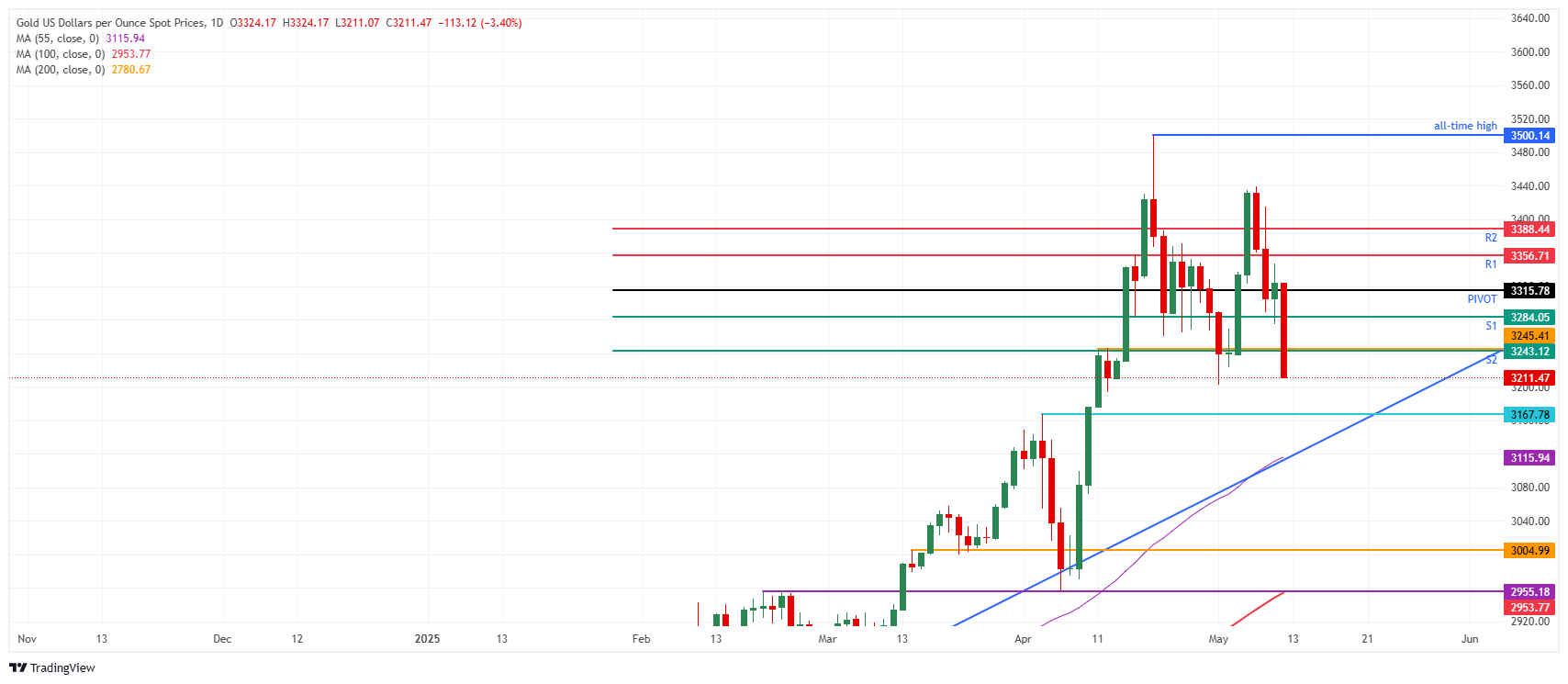Gold plunges on US-China trade deal leads to safe-haven exodus

- Gold price faces more than 3% losses intraday after US and China agree to a major reduction in tariffs for 90 days.
- China will lower its tariffs on US goods to 10% from 125%, while the US will do so to 30% from 145%.
- Safe-haven exodus leads Gold to break vital supports before technically ending the rally.
Gold (XAU/USD) sinks more than 3.0% at the start of the European trading session and heads towards $3,210 at the time of writing as the talks between the US and China have brought some low-hanging fruit for the equity markets. China has agreed to lower its tariffs on the United States (US) to 10% from the initial 125%, while the US will lower its tariffs on China to 30% from 145%, both for 90 days. The announcement caused a risk-on wave in markets, with investors fleeing from safe-haven assets such as Gold.
US President Donald Trump on Friday already hinted at the possibility that the talks could be productive and issued a general message to “buy stocks now” on his Truth Social Network. In this context, Gold has already lost over 8% from its all-time high at $3,500 reached on April 21
Daily digest market movers: Deep dive lower
- The US-China deal to temporarily remove tariffs has sent shockwaves in financial markets: US yields are climbing higher, with the US 10-year yield hitting 4.43%, a level not seen since the beginning of April. Expectations are that a surge in demand on the back of this tariff relief could lead to a spike in inflation.
- In the commodity space, Oil is rocketing higher by more than 2% to $62.50 at the time of writing, as demand is expected to pick up again as trade tensions ease.
- Equities are also surging, with Chinese stocks rallying over 1%. European stock indices see milder gains, while US futures are outperforming with gains between 2.50% and 3%.
- US Treasury Secretary Scott Bessent said that “neither the US nor China wants to decouple” and that he would like to see China open its market more to US goods. A possibility for a purchasing agreement is possible, Bessent went on to say in the statement, Bloomberg reports.
Gold Price Technical Analysis: Look for oversold levels
Time to roll up your tents and clear the field for the safe-haven outflow avalanche that will likely take place on Monday. Expectations are that a second wave of selling could take place once the US session comes online. It is not unlikely that, with the amassed selling orders, prices could drop below $3,200 soon.
Should this occur, the pressure is on both the S2 support and that technical pivotal level at $3,245 coinciding. Once that level snaps, look for a substantial leg lower, below $3,200, towards $3,167. With that move, nearly all gains from April and May would be erased.
Looking up, a whole list of levels need to be reclaimed in its recovery to retest the all time high at $3,500. First the daily S1 support (which is now a resistance) at $3,284 needs to be achieved. The daily pivot at $3,315 is up next, followed by the R1 resistance around $3,356 and the R2 up next at $3,388.

XAU/USD: Daily Chart
Tariffs FAQs
Tariffs are customs duties levied on certain merchandise imports or a category of products. Tariffs are designed to help local producers and manufacturers be more competitive in the market by providing a price advantage over similar goods that can be imported. Tariffs are widely used as tools of protectionism, along with trade barriers and import quotas.
Although tariffs and taxes both generate government revenue to fund public goods and services, they have several distinctions. Tariffs are prepaid at the port of entry, while taxes are paid at the time of purchase. Taxes are imposed on individual taxpayers and businesses, while tariffs are paid by importers.
There are two schools of thought among economists regarding the usage of tariffs. While some argue that tariffs are necessary to protect domestic industries and address trade imbalances, others see them as a harmful tool that could potentially drive prices higher over the long term and lead to a damaging trade war by encouraging tit-for-tat tariffs.
During the run-up to the presidential election in November 2024, Donald Trump made it clear that he intends to use tariffs to support the US economy and American producers. In 2024, Mexico, China and Canada accounted for 42% of total US imports. In this period, Mexico stood out as the top exporter with $466.6 billion, according to the US Census Bureau. Hence, Trump wants to focus on these three nations when imposing tariffs. He also plans to use the revenue generated through tariffs to lower personal income taxes.




